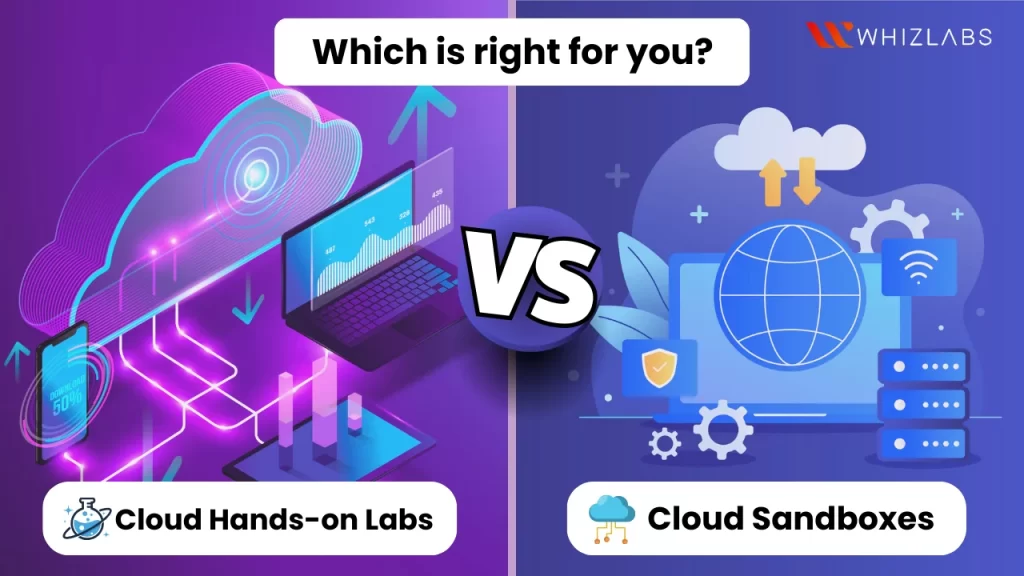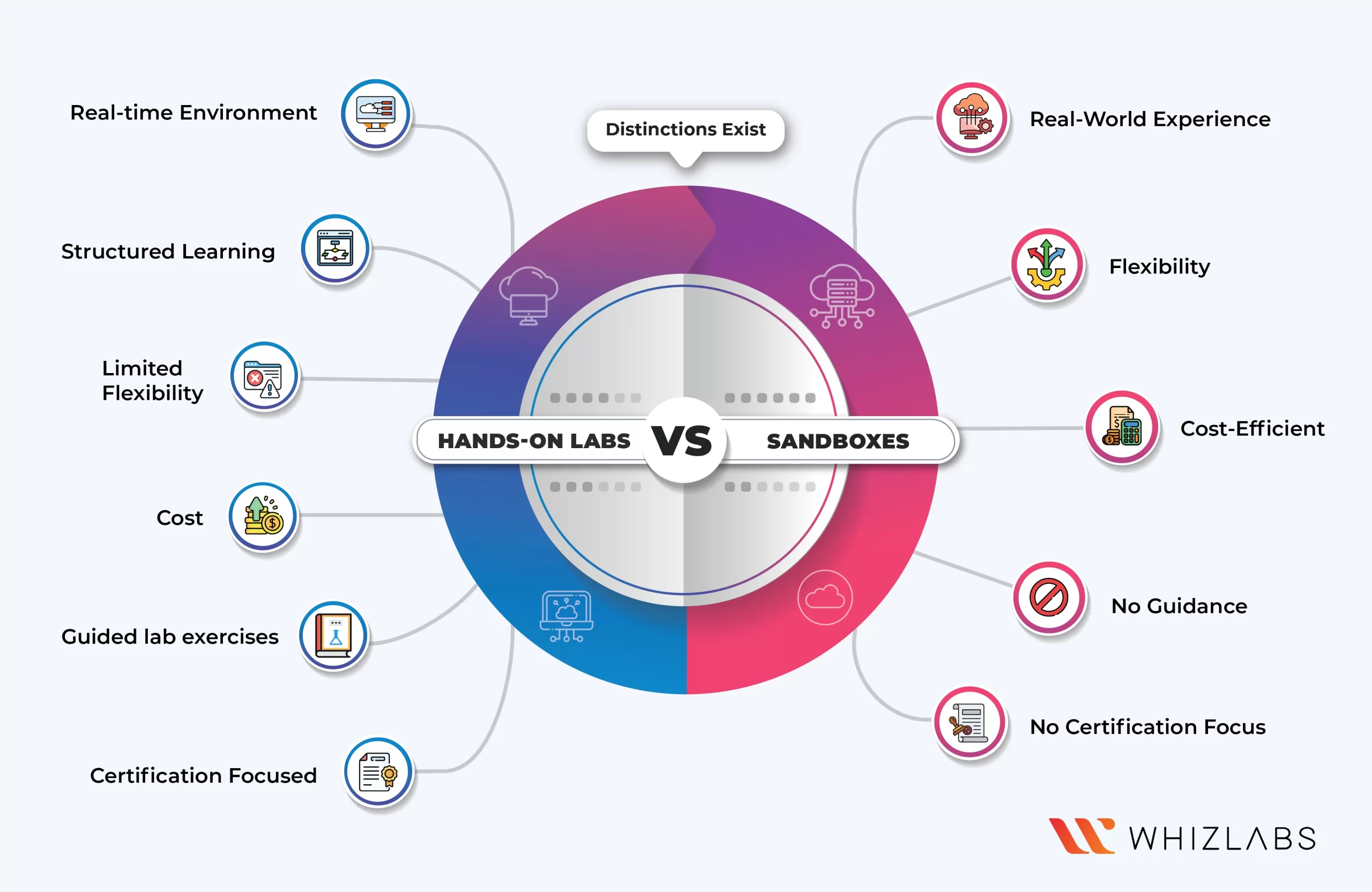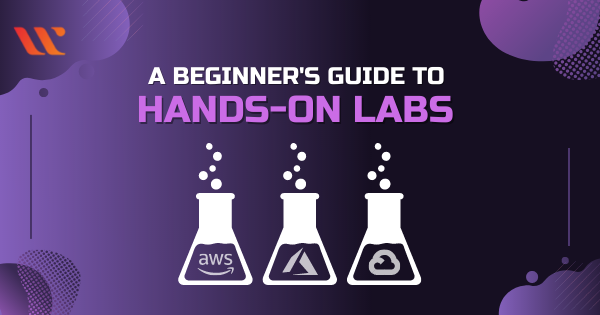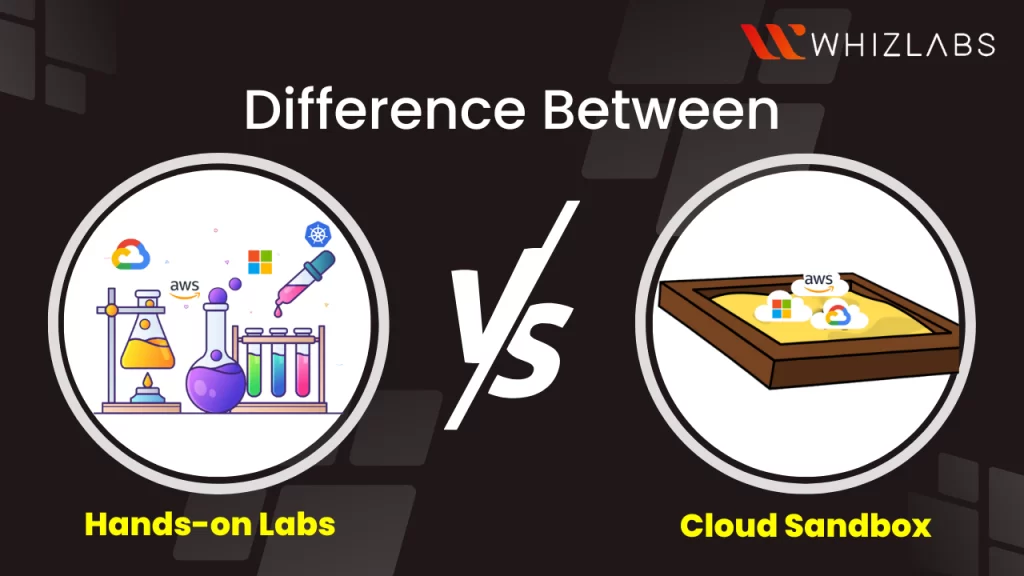Cloud computing has revolutionized the way we develop and deploy software. With the rise of cloud-based platforms, the terms “Hands-on Labs” and “Sandbox” have taken on new meanings.
In this blog post, we’ll explore the differences between Hands-on Labs and Sandboxes in the context of cloud computing. Based upon the differences, the decision can be made which is right for the users based on their scenarios.
Let’s jump in!
Overview: Hands-on Labs and Sandbox
In the realm of cloud computing, developers have two vital tools at their disposal: Hands-on Labs and Sandboxes. Hands-on Labs takes you on a structured journey within ready-to-use environments, providing guidance every step of the way.
On the other hand, Sandboxes hands you a blank canvas, allowing developers to freely tinker with their code and configurations, fostering a space for experimentation.
Let’s see hands-on labs and sandbox in detail.
Cloud Hands-on Labs: Learn by Doing
In the network of cloud providers, hands-on labs are referred to as a pre-configured virtual network environment which lets the users experiment with the cloud service as well as features without the requirement of their infrastructure.
These self-paced labs are offered by cloud service providers or third parties and guide the users with step-by-step guidance and tutorials.
It mainly assists the developers to get real-time hands-on experience with the cloud features and services that are introduced. Moreover, these hands-on labs are risk-free, controlled, and secured environments where the users can practice with varied settings and configurations without causing any hassles in production surroundings.
Cloud hands-on labs can be primarily used for clearing up the certification by honing their skills in practical means.
Hands-on Labs Types
Whizlabs offers various types of labs, each catering to different learning needs and levels of guidance:
- Guided Labs: Hands-on Labs grant you access to a cloud environment. However, they take a more structured approach. In Hands-on Labs, you receive step-by-step instructions that guide you through a series of actions. These instructions are designed to demonstrate the functionality of the cloud environment, providing a more directed learning experience.
- Lab Challenges: Hands-on Challenge labs present you with a scenario and task you with solving a problem. Unlike the other lab types that focus on familiarizing you with an environment, Lab Challenges are designed to test your knowledge and practical skills. They require you to apply what you’ve learned to real-world scenarios, making them a valuable assessment tool in your learning journey.
Cloud Sandboxes
In the cloud computing environment, the sandbox environment is a segregated environment that permits the software developers to carry out the testing and deploying of new applications and services without making any disturbances or changes to the production environment.
Cloud sandboxes are primarily employed for testing, development, and staging purposes, thus allowing the software developers to experiment with the new functionalities and features without causing any hassles to the live system.
In contrast to hands-on labs, sandboxes are not guided or pre-configured. Cloud sandboxes generally come up with a blank slate, which allows them to create or change the code until they get fit.
Developers mainly prefer sandboxes during the new software product development, for testing and refining the code before releasing it to the public.
Sandbox environments offer technologists an opportunity to immerse themselves in a real-world cloud computing setting, while leaders can rest assured that their cloud infrastructure remains safeguarded from inadvertent mistakes. It’s a mutually beneficial arrangement.
The appeal of custom sandbox environments further enhances this proposition. While it’s valuable for technologists to gain a general understanding of a cloud computing environment, working within a customized sandbox that closely mirrors their everyday workspace takes the experience to a whole new level.
Custom sandbox environments provide the crucial context that is often missing and offer a genuine taste of real-world experience.
Also Read : Hands-on Labs for AWS Certified Cloud Practitioner
Sandbox in varied forms
Based upon the purpose and platform, there exist six sandbox environments such as:
- AWS Sandbox: An AWS sandbox is like a playground for learning about Amazon Web Services. It’s a secure and isolated space where you can tinker with AWS services, experiment with configurations, and build things without worrying about messing up your actual AWS resources.
- Azure Sandbox: Just like AWS, an Azure sandbox offers a haven within Microsoft Azure. It’s a place where you can freely explore Azure services, try out different Azure features, and get hands-on experience without affecting your live Azure setup.
- GCP Sandbox: If you’re curious about the Google Cloud Platform, a GCP sandbox is your testing ground. It’s where you can dive into GCP services, practice cloud skills, and figure out how to make the most of Google Cloud’s tools without any real-world consequences.
- Power BI Sandbox: Imagine a place where you can play with Microsoft Power BI, the tool for making sense of data. A Power BI sandbox lets you create data reports, experiment with dashboards, and sharpen your data analysis skills in a safe environment.
- Code Sandbox: Think of a code sandbox as a virtual coding playground. It’s a web-based space where you can write, test, and run code in different programming languages. Perfect for coding experiments, quick projects, and learning to code without dealing with complex setups.
- Jupyter Sandbox: A Jupyter sandbox is like having a magic notebook for coding and data analysis. It’s an interactive space powered by Jupyter Notebook, where you can write and run code, create documents, and visualize data for everything from research to machine learning.
Cloud Hands-on Labs vs Cloud Sandbox
Hands-on Labs and Sandboxes stand as pivotal resources for developers within the realm of cloud computing. Hands-on Labs furnish a structured path with pre-set environments, while Sandboxes provide an open canvas for developers to test their code and configurations. Both tools hold undeniable importance in cloud-based software development, and each boasts distinct advantages.
By grasping the distinctions between these tools, developers can select the most suitable one for their unique requirements and fully harness the potential of cloud computing advancements.
Let’s see some distinctions exist between them:
Cloud Hands-on Labs
- Structured learning: Hands-on labs generally help to achieve structured learning as everything is previously defined with lab exercises and objectives. The utilization of the lab playgrounds can certainly guide you through the tasks and scenarios in step by step manner.
- Real-time environment: If you need access to the real cloud settings with the help of pre-configured resources, then you can go for the cloud hands-on labs. It helps to achieve a realistic experience in productive cloud environments.
- Guided lab exercises: The guided labs contain a complete package of documentation, tutorials, and expert support to complete the lab exercises with ease.
- Certification Focused: The hands-on labs are generally tailored to help individuals who want to be get certified in cloud platforms such as AWS, Azure, and GCP. If you’re the one, then relying on hands-on labs is the ideal choice.
- Limited Flexibility: The predefined nature of labs can limit your ability to experiment beyond the provided exercises.
- Cost: There are some free cloud labs provided by cloud vendors, but they come with limited access. To access all the features and functionalities of the labs, you must either go for a time purchase or a premium subscription.
Cloud Sandboxes
- Flexibility: While configuring the cloud network, the users may face challenges in accessing the cloud environment. Onestop’s solution for this concern is a sandbox as it can offer flexible accessibility to the cloud network. It means the users can be able to experiment, create their projects, and try various cloud services.
- Real-World Experience: With sandboxes, you gain hands-on experience with cloud resources in a more open-ended and real-world manner. This can be particularly beneficial for building problem-solving skills.
- Cost-Efficient: Some cloud providers offer free tiers for sandbox environments, allowing you to practice without incurring significant costs.
- No Guidance: Sandboxes typically don’t come with structured exercises or tutorials. You need to have a certain level of knowledge and be self-driven to make the most of them.
- No Certification Focus: It is not certification-oriented and it does not withhold any content that exists within the certification training materials in an aligned way.
Cloud Hands-on Labs vs Cloud Sandboxes: Which is right for you?
Hands-on labs can be valuable both for individuals who are already familiar with the platforms and for those who are new to them. They offer structured and guided learning experiences, making them suitable for a wide range of users, from beginners looking to get acquainted with the platforms to experienced individuals seeking specific training or practice on particular features or services.
Before implementing changes or deploying projects in live production environments, many professionals use cloud sandboxes to experiment and employ a trial-and-error strategy. Cloud sandboxes provide a safe and controlled space for testing configurations and services, reducing the risk of errors or disruptions in the production environment.
You can opt for the hands-on labs:
- If you are a newbie and need a structured learning path
- If you want to know how to proceed with guided lab exercises of various cloud platform
- If you want to grasp the skills and concepts in the limited time period
- To strengthen your fundamental skills on a cloud platform
You can go for cloud sandboxes if you:
- You want to level up your skills from basic to intermediate or advanced level
- Intend to explore the cloud in real-world settings
- Want to challenge yourself in trial and error strategy
- Need independent learning
The choice between Cloud Hands-on Labs and Cloud Sandboxes depends on your learning style and project requirements.
FAQs
What is a sandbox playground?
It is an isolated and standalone environment tailored for individuals who want to experiment, fail forward, and try new ideas without taking any risks.
Is the sandbox environment risky?
A Sandbox environment is a highly safe and secure environment to experiment with. The activities carried out in the sandbox playground do not have any impact or effect on the system or application functionalities.
What is cloud lab training?
Cloud hands-on labs empower learners to enhance their expertise in a particular skill or technology by providing clear, guided instructions, practice tasks, and hands-on projects.
Why are hands-on labs important?
Unlike tutorials that involve solely reading or listening to information, hands-on labs provide you with the opportunity to actively apply your newfound skills. Hands-on labs accelerate and enhance your learning process because they enable practical application and experimentation.
Conclusion
We hope this blog has provided you with a thorough understanding of sandboxes and hands-on labs. It’s essential to ensure that the sandbox and hands-on labs you choose are up-to-date and compatible with the latest application features. Keeping this consideration in mind, Whizlabs offers a wide range of more than 500+ hands-on labs covering AWS, Azure, Google Cloud, Power BI, Kubernetes, and cloud sandboxes.
These labs are incredibly easy to set up, require no ongoing maintenance or monitoring, come with 24/7 technical support, ensure a secure working environment, and deliver a seamless user experience.
- AWS Security Specialists: Essential in Modern Cybersecurity - August 16, 2024
- Cloud Developer Tools Showdown: AWS vs Azure vs GCP - August 14, 2024
- Master AWS Lambda and API Gateway for Application Development - August 6, 2024
- Benefits of AWS Developer Associate Certification which Can Boost Your Career - July 24, 2024
- Preparation Guide on Datadog Fundamentals Certification - July 17, 2024
- What is DLP in Power Automate? - June 5, 2024
- Top Data Engineering Certifications in 2024 - May 30, 2024
- How Difficult is Google Cloud DevOps Engineer Certification? - May 29, 2024



